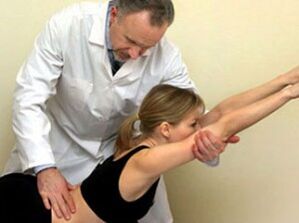There are probably few people who, after 30-35 years, do not periodically complain of a feeling of discomfort and pain in different areas of the back, temporary numbness of the legs or arms.Such manifestations may indicate the possibility of developing osteochondrosis.This disease is quite common and occurs when, under the influence of various reasons, the cartilaginous tissue of the spine begins to change, losing mobility and flexibility.This disease can develop in any part of the spine, but usually affects the discs between the vertebrae.If you move little or sit for a long time at work, the risk of developing osteochondrosis is very high.

People pay attention to discomfort and other changes associated with this disease, usually closer to the second half of life.
The risk of contracting the disease increases significantly if:
- you already know what age-related changes are;
- you have had (whenever) back injuries;
- you had to undergo excessive physical exertion;
- you are constantly in stressful situations;
- your work involves strong vibrations.
And in recent decades, osteochondrosis of the spine has also become noticeably “younger”.
Early onset of the disease is possible if:
- the person is in poor physical shape or posture;
- a person eats untimely or incorrectly;
- suffers from flat feet or curvature of the spine;
- the person has bad habits - overeating or smoking.
In addition, during pregnancy, the load on the spine also increases, which often causes osteochondrosis in girls and women.
Danger of osteochondrosis
How to treat osteochondrosis?In the early stages of osteochondrosis (first or second), its symptoms may be poorly expressed or not bother the person at all.This is dangerous because advanced osteochondrosis, in addition to discomfort and pain, can “give” you complications in the form of such serious diseases as kyphosis, radiculitis or intervertebral hernia.
What to do in case of osteochondrosis?- Treat, because if osteochondrosis is detected at an early stage, then you can completely get rid of it.
Modern methods used to treat osteochondrosis
In the comprehensive treatment of osteochondrosis of the spine, two methods are used: complex (conservative) therapy and surgical intervention.
Complex therapy (conservative)

Treatment of osteochondrosis includes a whole range of medicinal and complementary methods.This therapy is prescribed if you are in the early stages of this disease.
Treatment of grade 1 osteochondrosis is carried out by:
- use of drug treatment;
- local and general massage;
- a set of physiotherapy exercises;
- the use of reflexology and all the variety of physiotherapy methods.
Treatment of grade 2 osteochondrosis additionally requires the use of the spinal traction method.Spinal traction is performed using a load selected individually for each patient.For this, special equipment is used.The spinal traction procedure not only relieves acute pain, but also restores the correct position of your spine and increases the intervertebral space.
Medication methods
- the use of various anti-inflammatories and analgesics;
- the use of modern drugs that restore cartilage tissue.
Methods of drug use during drug treatment:
- all kinds of external rubbing and compresses.
- oral administration of tablets and capsules.
- procedures such as intravenous infusions and injections.
With drug treatment of osteochondrosis, pain is relieved, acute inflammation is relieved, muscle tissue is gradually relaxed, some affected cartilage is restored, blood supply and metabolic processes are improved.Such treatment of the disease is necessarily prescribed in case of exacerbation of the disease.
Additional methods

- specially developed therapeutic diet;
- massage and self-massage;
- physiotherapy methods;
- manual therapy;
- light underwater hydromassage;
- traction (traction therapy);
- acupuncture;
- traditional medicine;
- meditative relaxation;
- medicinal baths;
- a set of physiotherapy exercises;
- work with a psychotherapist.
Surgical (operative) treatment
Surgical treatment is used in the later stages of the disease (third and fourth), when other treatments tried are no longer effective.Treatment of later stages is more complex, since the main disease itself is already accompanied by other diseases of the spine - radiculitis, hernias.The indication for surgical intervention is the appearance of an intervertebral hernia.Sometimes it is even necessary to completely delete the affected disk.
Treatment of grade 4 osteochondrosis requires an extremely complex operation with a high risk of damage to the spinal cord nerves.Therefore, surgical treatment is extremely rare if attempts to cure a patient with osteochondrosis by other means have not helped.
How long does it take to treat osteochondrosis?
How to quickly cure osteochondrosis?It depends on the presence of pronounced age-related changes, the variability of the manifestation of symptoms and the variety of treatment methods used.The patient himself can also actively contribute to his recovery by scrupulously respecting the requirements of his treating therapist.
Treatment for grade 1 osteochondrosis usually lasts one to four months.In the 4th year, after surgery, the recovery period can take a year to a year and a half.Treatment also depends on the patient's personality.He must be positive, perseverant, voluntary and very motivated.
Treatment of different types of osteochondrosis
Osteochondrosis is distinguished by the location of the spinal lesion (its location).The location of osteochondrosis can be:
- cervical;
- chest;
- lumbar;
- widespread.
Main complaints:
- with cervical localization - a person periodically experiences pain in the shoulders and arms, as well as headaches.Due to the compression of the arteries, there is sometimes noise in the ears, colored spots and "floaters" in front of the eyes and slight dizziness.
- with thoracic localization - a person complains of pain like: “a stake was inserted into the chest”, “thumps” in the heart, stomach or lungs.
- with lumbosacral localization - a person complains of severe lower back pain, which can spread to the sacrum, groin and even legs.Some patients experience numbness in their leg muscles.
- with widespread localization, complaints arise regarding a wide variety of symptoms.With this form of the disease, a person complains of several types of symptoms at the same time.
How to treat cervical osteochondrosis?
Methods for treating osteochondrosis of the neck today are:
- analgesics, anti-inflammatories, antispasmodics;
- stimulants for tissue restoration, anti-inflammatory gels, ointments for external use;
- manual therapy;
- exercise therapy;
- hirudotherapy;
- reflexology;
- traditional medicine;
- surgical intervention if the case is particularly serious.
How to treat thoracic osteochondrosis?
Measures for treatment of breast type:
- painkillers and anti-inflammatory medications;
- acupuncture;
- manual influence;
- vacuum therapy;
- physiotherapy;
- cupping massage;
- traditional medicine;
- moxotherapy (warming with absinthe cigars).
Exercise therapy for chest diseases is used not only as an addition to general therapy, but also as a means of forming a muscle corset;among other things, exercise therapy prevents possible relapses.
How to treat lumbosacral osteochondrosis?

Treatment at different stages is carried out conservatively and surgically.
Conservative treatment of lumbosacral osteochondrosis in the early stages includes:
- drug therapy, in some cases hormones;
- manual influence;
- general health supplements;
- reflexology (acupuncture);
- lower back massage;
- traditional medicine;
- hirudotherapy (leeches);
- Exercise therapy.
Stage 4 lumbosacral osteochondrosis usually requires surgery.
How to treat common osteochondrosis?
Treatment of common osteochondrosis is carried out:
- prescribe appropriate drug treatment;
- use all types of manual therapy;
- physiotherapy exercises;
- use acupuncture methods;
- various methods of physiotherapy;
- development of a special diet.
Any type of osteochondrosis of the spine requires surgical intervention in only ten percent of cases.The operation can be prescribed to patients with complications, as well as if the patient late turned to specialists for treatment.If the diagnosis is made on time and you have already started treatment, it would be good if traditional methods of treating this disease were added to the traditional methods.Traditional methods have proven themselves well in the treatment of any type of osteochondrosis.
Treatment with traditional methods
Folk remedies for this disease are used only in combination with drug treatment.They aim to relieve inflammation, pain and discomfort.Decide for yourself how to treat osteochondrosis of the spine - using various traditional medicines or only by medical methods.

Popular folk remedies:
- take tonic pine baths;
- apply copper plates and coins to the spine.
- compresses with the addition of aloe juice;
- honey massage, honey wraps;
- fresh decoctions of herbs: oregano, hop cones and chamomile;Roots of St. John's wort, dandelion and burdock;
- apply horseradish leaves to a sore spot;
- apply rye or potato pancakes to the sore spot;
- sunflower tea;
- tincture of red elderberry;
- burdock compresses.
When you begin treatment for osteochondrosis, you may find that your pain will only get worse.This is a completely expected reaction of your body to unusual influences.Soon this pain will stop completely.The best way to treat osteochondrosis is to combine conservative therapy with postoperative rehabilitation in specialized centers.
How can a person get rid of osteochondrosis?
Here are the three most common questions that worry patients with osteochondrosis:
- How to get rid of osteochondrosis?
- How to quickly cure osteochondrosis?
- Where is the best place to treat osteochondrosis?
Doctors answer these questions differently, because the speed of recovery depends not only on the form of the disease, but also on how quickly the patient seeks treatment.
Experts can only guarantee complete recovery for the first and second stages of the disease.Therefore, you should immediately contact a therapist, even if you have only discovered certain symptoms.Although all modern methods of treating osteochondrosis are very effective, doctors consider the most effective therapy to be a combination of a set of traditional methods with constant training on stationary rehabilitation equipment.This treatment allows you to completely recreate the muscular corset and forget about the disease for a long time.
Why shouldn't a patient with osteochondrosis be treated at home?
- It is not recommended that a patient suffering from osteochondrosis be treated at home, since the lack of a special orthopedic bed, physiotherapy equipment and special exercise equipment can significantly reduce the effectiveness of treatment;
- Not every patient can constantly follow a daily routine, take prescribed medications on time, eat according to a diet or undergo all medical procedures.Additionally, many patients require periodic reminders to continue their treatment.
- At home, it is difficult to adhere to the correct diet recommended by a nutritionist.
Hence the conclusion: you can try to treat osteochondrosis at home, widely using traditional treatment methods, but the best solution would still be to go to a specialized clinic or hospital for this profile, constantly being under the supervision of a highly qualified therapist.



















